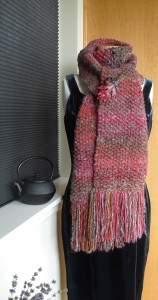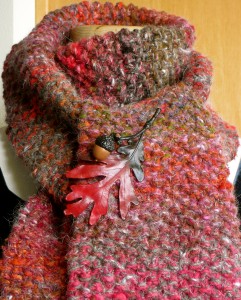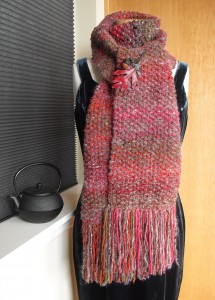There are even more beautiful ways to wear a large square shawl. As I promised I am continuing with my demonstrations using my 43″ square blue silk shawl with the 6″ hand tied fringe. Because I am showing more methods of styling this size and shape of shawl or scarf with this blue shawl I am continuing to identify them as part of the sequence of large blue shawl styles and they will be numbered as style # 6, #7,and #8 accordingly. You can find the previous styles in these former posts:
In an old original publicity shot for the movie The Tempest the great Scandinavian film actress Greta Garbo is wearing just such a long elegant evening shawl draped around her shoulders and pinned in place. The photo was taken shortly after her arrival in Hollywood. The studio was determined to capitalize on her exotic European elegance and extraordinary beauty to turn her into a top grossing international star. I searched and searched on the internet but could not find that photo to add to this post. I saw it years ago in a museum retrospective on her films and it has stuck in my memory ~ it was a full figure shot and she was leaning against a wrought iron wishing gate wrapped in a long shawl much like this one. Of course Garbo, in a lovely setting, wearing a beautiful vintage shawl shot by a professional Hollywood glamour photographer made a magnificent and alluring fashion photograph! In her honor I will name these three styles which she inspired after her!
Style #6) The Greta Garbo ~ Version A. Hold the shawl spread fully open. Fold the fringe of the shawl and about 2 inches of the top edge of the fabric forward so it will hang toward the inside facing the back of your neck. Place the folded edge of the long top side of the shawl at the middle of the back of your neck, bring it across your back and forward over your shoulders making sure the center is in the middle of your neck and back so both sides hang down in even equal lengths. Make sure the fringe is hanging straight. You have very simply draped the shawl evenly across your shoulders. This is the classic way to wear a large shawl in every country and every culture, for both warmth and graceful feminine beauty. It shows off the fabric, the design and style of the shawl, and the woman!
Style #7) The Greta Garbo ~Version B. Arrange the shawl as shown in Version A, Then bring both sides of the shawl together in the front and cross it over a bit in the center and clip it together in one or two areas to hold it firmly in place so that it doesn’t slip off your shoulders and fall to the ground.
That’s all there is to it! It is amazingly simple and lovely.
You can use one or more brooches or pins, a shawl clip or clips, a stick pin, or, as I did here, two vintage clip earrings. I have discovered that I can use clip earrings from the 1950’s which are too big and heavy for me to wear on my ears as shawl, scarf and sweater clips! It is great to have another use for these earrings because many of them are very pretty.
These vintage clip earrings are made of blue butterfly wings used to create little tropical landscape pictures complete with palm trees and sunsets! Jewelry and other objects made of butterfly wings were popular souvenirs from South America in the 30’s, 40’s and 50’s.
This is a good place to mention that I found this lovely large square fringed scarf/shawl at a thrift store for only $4! Isn’t that amazing as well? I recommend looking for scarves and shawls on a regular basis at vintage stores and thrift shops. I think people get rid of them because they don’t know how to wear them! Which is lucky for us who are willing to work with them and learn how to style and use them.
I have also realized that many different and interesting types of ethnic scarves and shawls become available on the second hand market. I think this happens when people get tired of things or think they are old fashioned. And when people immigrate to the United States or Europe, and want to wear the new contemporary clothing to fit in in their new homes, they often get rid of the ethnic styles and national costumes of their homeland!
Many lovingly handmade scarves and shawls are also given away or gotten rid of. I have found an East Indian sari, silk scarves from occupied Japan, a Ukranian shawl, a handwoven Tibetan silk scarf, an embroidered Spanish shawl, a French Leonard of Paris designer silk scarf, four British Liberty of London scarves, an Italian silk scarf, 3 Italian Missoni designer scarves, a hand knitted traditional Irish scarf, a Mexican rabosa shawl, an Indonesian batik sarong scarf, an Estonian hand knitted lace shawl, a hand made Breton lace scarf, a Scottish cashmere shawl, an old East Indian paisley shawl, a Russian flowered wool challis shawl, a Thai silk stole, a mink fur stole, a British wool and cashmere muffler from Burberry of London, several American designer mufflers, a Spanish mantilla, and many more in second hand and thrift shops! I am often happy to rescue a beautiful ethnic textile or a handmade or historical vintage piece! I realize I have accumulated a pretty good collection of beautiful and historical international scarf styles which is why I am now completely committed to learning how to wear them all!
For me, and many other women, scarves are purely fashion and style statements – beautiful expressions of the art of femininity! I was initially interested in them as textiles and clothing and only later realized they were not only means of expressing oneself fashionably and artistically, but also embodied complex social, philosophical, cultural and religious issues and beliefs. I learned that these squares, rectangles and triangles of cloth often represent much more than geometric shapes or beautiful ways to drape the body or set off your face. And I will write more about that at a later time.
I also noticed, in artists renderings, that many great beauties of history have often been draped in flattering shawls and scarves! Queen Cleopatra is beautifully draped in artists portraits. Helen of Troy as well! The notoriously beautiful Spanish dancer, Lola Montez, was wearing a magnificent Chinese embroidered piano shawl with long silk fringe when I “met her” in the photographic portrait gallery of the Metropolitain Museum of Art in New York City. I first discovered her and developed an interest in her when I viewed her portrait on exhibit there! The modern dancer Isadora Duncan was also famous for wearing her reconstructed versions of draped Grecian style dresses and trademark blue shawls.
The list of glamorous and beautiful women in shawls goes on forever! Because I became interested in this subject I noticed them everywhere! That is how I eventually got to Greta Garbo! Years ago I saw several of her silent movies at a museum in Los Angeles and noted the shawl she wore and how she was wearing it in the film The Tempest right away! She was so beautiful and carried it off so well that I committed the image to memory and have often worn and fastened my own large shawls inspired by the way she wore them! This one is my favorite!
Stlye #8) The Greta Garbo ~ Version C ~ Another way Garbo the great wore her long fringed shawl in the film The Tempest. Wrap the shawl over the shoulders bringing the Left side all the way across the front overlapping it to the Right shoulder. Secure it in place with a brooch or shawl clip. I used my Eissenberg Ice blue and silver brooch because it is a lovely look with this shawl. It is there on the Right shoulder of the mannequin, but it is so sparkly it is almost blinding! That makes it hard to see in the photograph. I assure you, it both attractive and very noticeable in person!
This manner of styling makes a beautiful long formal evening wrap over a long columnar dress. It would be lovely worn over a simple bias cut spaghetti strapped gown! I would ideally have that in a dark royal or navy blue with this particular shawl!
I have always loved Garbo. I love to reference her in her films for clothing designs, makeup ideas, hair styles, and, of course, the incredible evening gowns designed for her by Adrian. Together they created great art in film fashion and, it epitomized femininity as an art form.
In my opinion no one, and nothing in the world that came before or after Greta Garbo, could possibly be more elegant!
I will continue to search for the publicity photos I saw of her wearing a shawl like this for The Tempest and post them here if and when I find them.
Speaking of artist’s renderings of supreme beauties there was another film, starring Garbo, in which she plays a popular artist’s model in Paris. A long and dramatic story that I cannot remember much about, including the name of it, although I distinctly remember the artist studio scenes with her posing for the painters and sculptors in them. As with most of the horribly melodramatic stories in the majority of her films it is not memorable as a movie, but it is worth seeing to see her and her fabulous clothes. I am always amazed at how Hollywood dressed the actresses playing starving artist’s models and other poor working women in those movies in extravagantly beautiful and outrageously expensive designer clothes.
Of course, like all the girls and women who saw these actresses, it made me want to be like them and dress like them. And that was the point, wasn’t it? The movies did a lot for fashion in their heyday! I think that they are hugely responsible for the fact that women were more glamorous in general back then and dressed as much as possible like these stars in their real lives.
Because I love that period of fashion history and it inspires me so much I try to dress that way myself now, whenever I get the chance.Of course this takes effort and time but it is well worth it to bring more beauty and pleasure into the world for people to enjoy!
I am grateful for the inspiration I receive from all the people who worked in the old movies to create the glamorous effects we associate with the great stars of the old Hollywood films! These actresses were beautiful women to begin with but their memorable images were also created with the help of many experts. The makeup artists, hair dressers, costume designers, lighting experts, photographers, brilliant film directors and publicity departments and the writers all contributed to create the final images.
The making of a great legendary Hollywood beauty and star of the old days of high glamor depended on a lot of people doing an incredible amount of high level creative work!
I think about that every time I set out to get dressed up for a high level social effect on my own! I think it must be a lot harder for me than it was with all that professional help! But this is real life, not the movies. I am only inspired by the old movies. I don’t live in them!
Thus, I try to get organized well in advance as I have found that that really helps me. By this I mean laying out my clothes and jewelry and shoes. Trying them on a couple of days ahead of the event for a dress rehearsal. That way, if anything needs to be repaired of altered I’ll have time to take care of it in advance. Figuring out any color co-ordinated makeup I need to plan on wearing in advance, etc. And figuring out some kind of wrap if it will be necessary to get from place to place on a cold winter’s night without freezing to death! Fur coats were popular in the old days for good reasons! They kept you warm as you went from place to place.
A shawl such as this is a good evening wrap in the late spring and summer, but in fall and winter it will not be warm enough worn alone as an outdoor wrap. In such a case you can wear a fur coat or long evening cape to the event and either carry or wear the shawl as neck scarf. When you arrive at the event, check your cape or fur coat, then go to the powder room and style your shawl as shown in one of the photos above. This way, if you are in a cold drafty venue, which is often the case, wearing a lightweight evening dress with bare shoulders or no sleeves, you can wear the shawl to both stay warmer and look more glamorous! I did this at a winter black tie event this year and was the only woman there who was not covered with goose bumps! I also got a lot of compliments on my beautiful shawl!
I can imagine someone saying carry it? What does she mean, that would look tacky! Here is what I did. I carried a black satin evening purse, sort of a pouchy style between small and medium size. I rolled the above scarf up in a tight and quite small roll and put it into the purse along with a lipstick and a folding comb, and my brooch to pin the shawl. When I arrived, in high style, I checked my long black velvet evening cape and went to the ladies lounge, took my shawl out of my evening bag and put it on in front of the mirror. Then I checked my hair and lipstick, went out and checked my purse, because I don’t like having to hold onto those during an evening, and joined the guests. Many women who were purple with cold commented on how smart this was and said they had never thought of doing it! I got through the evening looking grand and managed not to catch a cold! Silk is amazingly warm, in case you don’t know. It can actually be too hot during the summer.
Another thing worth mentioning is that I felt glamorous because I was not cold. I was comfortably warm. I do not find suffering in any way to be glamorous and, I really enjoy being glamorous. In order to feel elegant and beautiful I have to be comfortable in every way as well as feeling assured that everything I am wearing is properly co-ordinated and put together and the proper choice for whatever I am attending or wherever I am going. I love coats and capes and shawls and furs and knitted sweaters and winter scarves because they are beautiful fabrics and designs, but also because they keep me warm and comfortable. Greta Garbo wore a lot of gorgeous furs in her movies! And I always take note of this fact!















